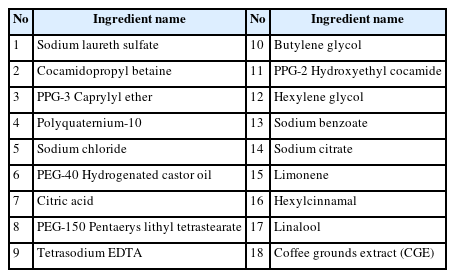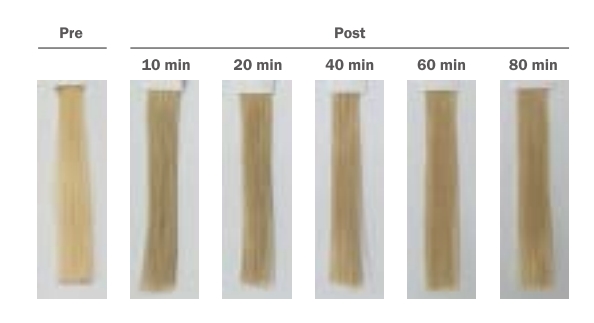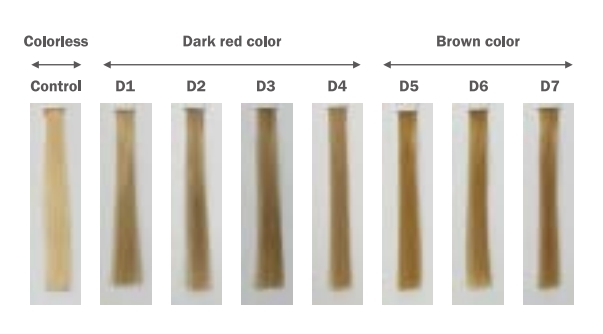커피찌꺼기 추출물(Coffee Grounds Extract)에 의한 모발 염색효과
Effects of Hair Dying by Used-up Coffee Grounds Extract (CGE)
咖啡渣提取物的染发效果
Article information
Abstract
목적
본 연구는 커피찌꺼기의 재활용 방안으로 커피박 추출물의 염모력을 알아보고 염모제로서 기능이 가능한지 확인하였다.
방법
커피박 추출물의 폴리페놀 함유량을 Folin-Ciocalteu 방법으로 측정하였고, 다양한 농도의 커피박 추출물이 함유된 샴푸제형을 제조하였다. 추출물이 첨가된 샴푸로 도포하여 추출물농도 그리고 염색기간에 따른 염색효과를 L*, a*, b*값으로 비교 분석하였다. 염색모의 물빠짐은 흡광광도계로 사용하여 퇴색도를 측정하였다.
결과
커피박 추출물은 122-133 mg GAE/g 폴리페놀을 함유하고 있으며 함유량에 따라 염색효과가 증가하였다. 샴푸제형으로 도포시 추출물 첨가농도가 증가할수록 그리고 도포기간이 길어질수록 염모력이 증가함을 알 수 있었다. 커피박 추출물로 염색한 염색모의 퇴색도는 21일 동안 변화가 없었다.
결론
다량의 폴리페놀을 함유하고 있는 커피박 추출물을 활용한 천연염모제로서의 가능성, 더 나아가 샴푸 제형으로의 상용화 가능성까지 시사한다.
Trans Abstract
Purpose
This study aimed to examine the effects of hair dyeing employing used-up coffee grounds extract (CGE).
Methods
The total polyphenol concentration of CGE was analyzed using the Folin─Ciocalteu’s method, and a shampoo formulation was prepared by adding different CGE concentrations. The hair dyeing effectiveness was observed according to changes in these two variables: dyeing concentration and dyeing time. To investigate the dyeing effects, L* (Lightness), a* (Red─Green), and b* (Yellow─Blue) values were measured using a colorimeter. The optical density value was measured to examine the hair’s fading degree after bleaching.
Results
The total polyphenol concentration in CGE was 122─133 mg GAE/g. The samples showed significant dyeing effects before and after application in terms of L*, a*, and b* values. Hair dyeing ability increased with both amplified CGE concentration and dyeing time. Regarding the bleaching process, no decrease in hair colour intensity or change in hair’s fading degree was observed for 21 days.
Conclusion
The possibility of dyeing using CGE has been demonstrated, and further commercialization as a shampoo formulation is considered possible.
Trans Abstract
目的
本探讨使用废咖啡渣提取物 (CGE) 进行染发的效果。
方法
通过使用添加了提取物的洗发水,使用L*、a*和b*值对根据提取物浓度和染色时间的染色效果进行比较和分析。并使用吸光光度计测量染发的褪色程度。
结果
CGE中总多酚浓度为122─133 mg GAE/g。样品在施用前后的L*、a*和b*值方面显示出显着的染色效果。当用作洗发水配方时,发现染发力随着提取物浓度的增加和使用时间的增加而增加染发能力随着 CGE 浓度和染色时间的增加而增加。在漂白过程中,21天内没有观察到头发颜色强度下降或头发褪色程度变化。
结论
使用CGE染色的可能性已经得到证明,并且作为洗发水配方进一步商业化被认为是可能的。
Introduction
커피는 전세계적으로 가장 흔하게 소비되는 음료 중 하나로서 하루 평균 22억잔이 넘게 소비되는 커피의 세계 소비량은 해마다 점차 소비량이 늘어나는 것으로 확인되고 있다(Grosso et al., 2017; Kim et al., 2013b). 국제커피기구(International Coffee Organization)에서 발표한 2020-2021년 자료에 의하면 한국의 연간 커피 소비량은 15만 톤으로 세계 6위를 기록하고 있고, 2022년 국내 커피수입량은 사상 최대치인 20만 톤을 기록했다. 이러한 커피시장의 급성장으로 인해 가공 부산물인 커피찌꺼기의 처리에 대한 문제가 야기되었다(Lee et al., 1998; Lee et al., 2010; Rim et al., 1995).
커피원두는 단 0.2 %만 커피를 추출하는데 사용되고 나머지는 버려진다. 즉, 커피콩 중 실제로 우리가 마시는 추출물은 사용한 커피콩 무게의 0.2 %에 불과하고 99.8 %의 원두는 커피박이 되어 버려진다(Silva et al., 1998). 커피박은 커피를 만들고 남은 부산물로, 보통 ‘커피 찌꺼기’라고 불린다. 커피박은 생활폐기물로 분류되어 연간 최대 5만 3천 톤이 소각, 매립되고 있다. 현재 커피박을 지속가능한 에너지원으로 활용하고 하는 노력으로 폐수정화 처리(Rim et al., 1995), 축산농가 퇴비 및 사료(Lee et al., 1998), 커피비누, 방향제, 비료를 제조하거나 바이오 디젤 원료(Lee et al., 2010)등으로 재활용되고 있지만 그 사용량은 미미하다. 이러한 관점에서 커피박의 효율적인 산업적 활용방안 연구가 필요한 실정이다.
커피는 사람들과 소통을 위한 사회적 음료로써의 가치를 가지고 있고, 또한 최근에는 커피에 함유된 폴리페놀 화합물의 기능성이 크게 주목받고 있다(Kang et al., 2016). 커피의 총 폴리페놀 함량은 100-200 mg GAE/100 g로 알려져 있으며(Olechno et al., 2020; Kang et al., 2016) 그 중 클로로겐산은 몸속의 활성산소를 제거해주는 항산화 효과를 나타낸다는 연구결과가 있다(Borrelli et al., 2002; Farah & Donangelo, 2006).이러한 식물성 폴리페놀류는 공기 중의 산소와 접촉하면서 폴리페놀 산화효소에 의해 퀴논으로 산화되고 이것이 산화, 중합, 축합의 비효소적 반응의 결과, 멜라닌 형성을 통해 갈색으로 변화하게 된다(Chen et al., 1991; Gauillard & Richard, 1997; Kim & Uyama, 2005; Martinez & Whitaker, 1995; Nicolas et al., 1994; Williams et al., 1986). 커피는 천연색소로 사용되어질 수 있는 다량의 식물성 폴리페놀류을 함유하고도 천연염료로서 연구는 미비한 실정이다(Choi & Jeon, 2009; Lee & Ko, 2016).
오늘날 인간의 평균수명 연장으로 노령화 인구가 급증하고 있다. 이들 실버세대들의 더 젊고 아름다워지고자 하는 욕구는 모발에 있어 노화에 따른 백모의 염색으로 이어졌다(Kim & Park, 2014). 그러나 염색에 사용되는 대부분의 합성염모제는 여러 가지 인체에 해로운 물질들로 구성되어 있어 두피나 모발 등 인체에 많은 부작용을 유발한다(Kim & Park, 2014; Rauscher et al., 2004). 이에 반해 천연염료는 인체에 무해하고, 환경을 오염시키지 않아 많은 연구자들에 의해 합성 염모제의 대안으로 연구되고 있다(Kim et al., 2013a; Mun & Kim, 2013; Shin & Park, 2014; Yang, 2013; Hong & Park, 2013).
본 연구는 버려지는 커피박 재활용 방안으로 다량의 폴리페놀을 함유하고 있는 커피박 추출물의 천연염모제로서의 가능성을 확인하고 커피박 추출물을 이용한 염색 샴푸 개발 더 나아가 샴푸 상용화 가능성 확인에 목적이 있다.
Methods
1. 재료 및 기기
본 연구에서 사용된 커피 및 커피박 분말은 2022년 5월 한 달간 스타벅스 매장에서 사용 후 수집된 에티오피아 원산지의 코페아 아라비카(Coffea Arabica) 품종으로 60℃에서 48 h 동안 건조하여 건조 커피박을 사용하였다. 연구에서 사용된 시료 모발은 원산지는 중국이고 아시아인 인모로 제작된 탈색모이다. 염색 테스트 피스 모다발 모델명으로 비프리윤 협력사(사업자등록번호 7656500372)를 통해 구입하여 실험하였다. 실험에 사용된 시약 중 폴린시오칼토 페놀시약(Folin & Ciocalteau's phenol reagent), 탄산나트륨(sodium carbonate), 갈릭산(gallic acid)은 Sigma-Aldrich (USA) 제품을 구입하였다. 장비는 분광색차계(ColorReader CR1; SHENZHEN THREENH TECHNOLOGY, China), 흡광광도계(CLARIOstar Plus; BMG LABTECH, Germany), 감압저온회전농축기(EYELA NVP-1000, CCA-1112A, N-1300, SB-1300; Tokyo Rikakikai, Japan)를 사용하였다.
2. 시료제조
1) 커피 및 커피박 열수추출, 여과, 농축, 건조
고농도의 폴리페놀을 용출하기 위해 건조 커피박 150 g을 정제수 1500 mL에 넣어 80℃에서 6 h 동안 열수 추출하였고, 2500 rpm에서 2 min 원심분리 후 상층액만을 1차 분리하였고 분리된 상층액을 감압여과기(EYELA NVP-1000; Tokyo Rikakikai)로 여과하였다. 이후 감압저온회전농축기(EYELA NVP-1000, CCA-1112A, N-1300, SB-1300; Tokyo Rikakikai)로 농축하였고 농축물에 소량의 정제수를 첨가하여 녹인 후 plate에 옮겨 60℃ dry oven에서 48 h 이상 건조하여 파우더 형태의 커피박 농축가루를 얻어 실험에 사용하였다. 커피 또한 동일하게 열수 추출하였다.
2) 커피박 샴푸제형 제조
본 연구에서 사용된 샴푸원액은 엘라스틴 샴푸 모델명으로 엘지생활건강에서 구입하여 실험하였다. 소듐라우레스설페이트, 코카미도프로필베타인, 피피지-3카프릴릴에터, 폴리쿼터늄-10, 소듐클로라이드, 피이지-40하이드로제네이티드캐스터오일, 시트릭애씨드, 피이지-150펜타에리스리틸테트라스테아레이트, 테트라소듐이디티에이, 부틸렌글라이콜, 피피지-2하이드록시에틸코카마이드, 헥실렌글라이콜, 소듐벤조에이트, 소듐시트레이트, 리모넨, 헥실신남알, 리날룰 성분이 포함된 샴푸원액에 열수추출, 여과, 농축, 건조하여 얻어진 커피박 농축가루를 1%, 2%, 3%, 4%, 5%, 6%, 7%, 8%, 9%, 10% 농도(g/mL)로 첨가하고 균일하게 혼합하여 줌으로써 모발 염색용 샴푸를 제조하였다(Table 1).
3. 모발염색 실험 방법
1) 열수추출액을 이용한 모발염색
커피박 추출액의 염색 전후 시간에 따른 모발시료의 색 변화를 관찰하기 위해 열수추출액 15 mL에 모발시료를 담가 각각 10 min, 20 min, 40 min, 60 min, 80 min간 염색한 후 증류수에 수세하고 자연건조 후 분광색차계(ColorReader CR1; SHENZHEN THREENH TECHNOLOGY, China)로 측정하였다.
2) 샴푸제형을 이용한 모발염색
샴푸제형에서의 커피박 농축가루 함유농도와 실험시간에 따른 모발시료 색 변화량을 관찰하기 위하여, 제조한 모발 염색용 샴푸를 이용하여 탈색한 인모 시료에 하루에 한 번, 3 min간 샴푸 처리한 후 흐르는 증류수에 수세하고 자연건조한 후 모발염색 정도를 분광색차계(ColorReader CR1, SHENZHEN THREENH TECHNOLOGY)를 이용하여 측정하였다. 7일 동안 지속된 실험에서는 위 시험을 매일 반복하였다.
4. 총 페놀 함량 분석
총 페놀 함량은 폴린시오칼토(Folin-Ciocalteu's) 방법으로 측정하였다(Kang et al., 2016; Kim et al., 2003). 96 well plate상에 각각의 샘플 용액 25 μL에 3차 증류수 200 μL와 폴린시오칼토 페놀시약 25 μL을 첨가하여 실온에서 5 min간 반응시킨 후, sodium carbonate 용액 25 μL을 혼합하였다. 이 혼합 용액을 어두운 실온에서 1 h 동안 반응시킨 후, 흡광광도계 ELISA reader (CLARIOstar® Plus, BMG Labtech, Germany)기를 이용하여 725 nm에서 흡광도를 측정하였다. 측정된 흡광도는 갈릭산(gallic acid)으로 작성된 검량선을 이용하여 총 페놀 함량을 계산하였다. 실험은 3번 수행하였으며, 이에 따른 평균값과 표준오차는 Microsoft Excel program을 이용하여 분석하였다.
5. 염색효과 측정
모발의 염색력을 측정하기 위해 각각 커피박 함유농도와 도포시간을 달리한 조건에서 모발 시료의 표면색상 변화를 알아보고자 분광색차계(ColorReader CR1, SHENZHEN THREENH TECHNOLOGY)를 이용하여 염색효과를 측정하였다. 이 때 모든 실험은 동일한 조건하에서 수행하였고, CIELAB 표색계의 색상 값인 명도지수 L*과 색좌표 지수인 a*와 b*값을 측정하였다(Lim, 2021). 이때 광원과 광측 조건은 D65/10°의 조건이었고, 측정값의 신뢰성을 높이기 위해 3회 측정하여 분석하였다.
L* : CIELAB 표색계의 white-black축에서의 명도 지수
a* : CIELAB 표색계의 red-green 축에서의 채도 지수
b* : CIELAB 표색계의 yellow-blue 축에서의 채도 지수
6. 물 빠짐 측정
커피박으로 염색한 염색모의 색상 지속력 및 물 빠짐 정도를 알기 위한 퇴색도 측정 방법은 흡광광도계 ELISA reader (CLARIOstar Plus; BMG Labtech)기기를 이용하여 측정하였다. 100 mL 비이커에 정제수를 넣고 커피박으로 염색된 시험군 시료를 담근 후 24 h 후에 시료에서 염색물이 빠진 정제수를 일자별로 흡광광도계 이용하여 660 nm에서 추출된 용액의 optical density (O.D.)값을 측정하였다(Kim, 2021). 측정기간은 21일 동안 24 h 주기로 측정하였고 물 빠짐 측정을 위해서는 모든 시료를 사용하지는 않고, 커피박 농축 5% 농도로 염색된 염색모로 물 빠짐 측정을 하였다. 실험은 3번 수행하였으며, 이에 따른 평균값과 표준오차는 Microsoft Excel program을 이용하여 분석하였다.
Results and Discussion
1. 커피박 추출액을 이용한 모발염색
커피찌꺼기의 모발염색 가능성을 우선 확인하기 위해 커피박 열수 추출액으로 염색시간을 10 min, 20 min, 40 min, 60 min, 80 min으로 하여 각 실험군의 L* (명도), a* (적색도), b* (황색도)값 확인을 통해 염색 효과를 측정하였고 결과값을 Table 2에 나타내었다. 모든 추출용해물로 염색한 실험군에서 시험 전 대비 L* 평균값은 감소하고 a* 평균값과 b* 평균값은 증가하였다. 추출용해물로 염색한 실험군내에서 또한 염색 시간이 증가할수록 L*값은 점차 감소하고 a*값과 b*값은 점차 증가함을 확인하였다. 이는 Figure 1에서 확인된 바와 같이 육안으로도 점차 흑갈색으로 변함으로써 커피박을 이용한 모발 염색 시 염착이 잘 되어, 미용에서 적용 가능한 방법으로 커피박 추출물의 염모력을 확인하였다.
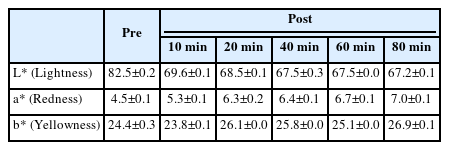
Colorimetric values of hair dyed with used-up coffee ground extract liqueur at different dyeing times
2. 추출물의 폴리페놀 함유량 측정
플라보노이드(flavonoid)류, 페놀산(phenolic acid)류 및 식물성 에스트로겐(phytoestrogen) 등을 포함하는 페놀류는 식물의 2차 대사 산물로 단백질 및 기타 거대분자와 결합하는 성질을 가지고 있다고 보고되어 있다(Othman A et al., 2016). 또한, 이러한 식물성 페놀류는 공기 중의 산소와 접촉하면서 폴리페놀 산화효소에 의해 퀴논으로 산화되고 이것이 산화, 중합, 축합의 비효소적 반응의 결과, 멜라닌 형성을 통해 갈색으로 변화하게 된다(Chen et al., 1991; Gauillard & Richard- Forget, 1997; Kim & Uyama, 2005; Martinez & Whitaker, 1995; Nicolas et al., 1994; Williams et al., 1986). 기존연구에서 Kang et al. (2016)은 커피와 커피박 샘플을 분석한 결과 커피박에서 가장 높은 총 페놀 함량을 확인하였고 Kim & Han (2009)은 로스팅 정도에 따른 커피의 총 페놀화합물 함량은 94.98-199.13 mg GAE/g으로 보고하였다.
커피박 추출물(CGE)과 커피 추출물(CE)의 폴리페놀 함유량을 알아보기 위해 분광측색계로 725 nm 범위에서 흡광도(absorbance)를 측정하였다. 모든 샘플은 동일한 농도(1 mg/mL)로 제조하여 실험에 사용하였다. 측정에 사용된 positive control은 gallic acid로 농도값과 흡광도값을 이용하여 기준 그래프(standard graph)를 완성하였고 산출된 식을 이용하여 각 추출물의 흡광도값으로 폴리페놀 농도를 확인하여 결과값을 Figure 2에 나타내었다. 세번의 독립적으로 진행한 실험 결과, 커피박 추출물(CGE)의 폴리페놀 농도는 133.6±4 mg GAE/g, 112.2±4 mg GAE/g, 112.2±4 mg GAE/g이며 커피 추출물(CE)의 폴리페놀 농도는 79±2 mg GAE/g, 69.3±2 mg GAE/g, 74.9±2 mg GAE/g로 측정되었다. 본 실험에서 동량의 커피 추출물(CE) 대비 커피박 추출물(CGE) 총 폴리페놀 함량의 상대적 우수성은 가공 부산물인 커피박의 활용 가능성을 보여주었다. 위 추출물을 농축 후, 샴푸제형으로 제조하여 이후 염색효과 시험에 사용하였다.
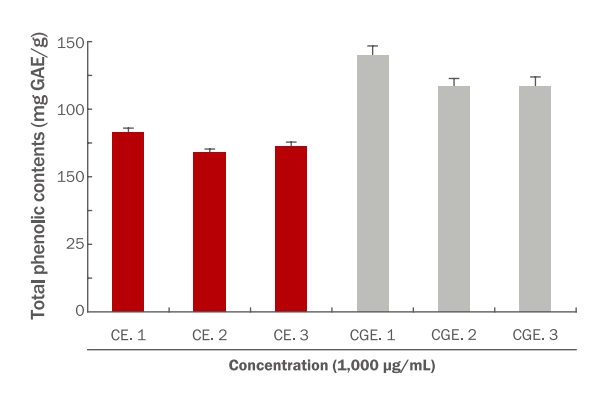
Total phenolic contents (mg GAE/g of dried extract) of coffee extract and coffee ground extract.
The total polyphenol concentration of both coffee and coffee grounds extracts (CE and CGE, respectively) was analyzed using the Folin─Ciocalteu’s method. The total phenolic content of the CGE was found to be higher than that of the CE. Data analysis was performed using Microsoft Excel. Each value represents the mean ± standard deviation (SD) of three replicates. Error bars represent S.D., n=3.
3. 폴리페놀 함유 농도에 따른 염색효과 (샴푸제형)
폴리페놀 함유 농도에 따른 염색효과를 알아보기 위해 폴리페놀 농도가 확인된 커피박 추출물(CGE)과 커피 추출물(CE)을 샴푸제형(5 %)으로 제조 및 도포하여 3 min 후에 물로 씻어낸 후, 각 실험군의 L* (명도), a* (적색도), b* (황색도)값을 통해 염색력을 측정하였다(Table 3). L*은 밝기인 명도(depth)를 표현하는 수치로 0에서 100 사이의 수치로 표시한다. 이때 0은 black을 나타내고, 100은 white를 나타낸다. Control 대비 추출물 CGE, CE 모두 a*값은 증가하고 b*값과 L*값은 감소하였다. 추출물 CGE과 CE 비교 시, 폴리페놀 함유 농도가 높은 추출물 CGE에서 L*값 특이적으로 감소함을 보여주었는데 이는 육안으로도 암적색 및 진한 암적색으로 변함이 확인되었다(Figure 3). 이는 폴리페놀 함유량이 많을수록 염색효과가 증가하고 명도가 낮아지는 것으로 사료된다(Chen et al., 1991; Gauillard & Richard-Forget, 1997; Kim & Uyama, 2005; Martinez & Whitaker, 1995; Nicolas et al., 1994; Williams et al., 1986). 또한 샴푸제형의 형태로도 염색효과가 유도됨을 확인하였다. 이후 실험은 커피박 추출물(CGE)이 함유된 샴푸제형으로 진행하였다.

Comparison between the colorimetric values of hair dyed with used-up coffee ground extract and coffee extract

Dyeing results of hair samples with coffee extract and used-up coffee grounds extract.
While comparing the dyeing effects of coffee and coffee ground extract (CE and CGE, respectively), notable color changes were observed. Nevertheless, the hair dyeing ability of CGE is better than that of CE, since it, has a higher phenolic concentration than CE.
4. 커피박 추출물(CGE)을 이용한 모발염색(샴푸제형)
1) 추출물 함유 농도에 따른 모발염색 효과(1%-10%)
폴리페놀 성분이 함유된 커피박 추출물(CGE)의 농도에 따른 염색효과를 알아보기 위해 추출 및 농축한 농도 1%, 2%, 3%, 4%, 5%, 6%, 7%, 8%, 9%, 10%을 샴푸제형으로 제조 및 도포하여 10 min 뒤 씻어낸 후에 L* (명도), a* (적색도), b* (황색도)값을 확인하였고 Table 4에 나타내었다. 육안으로(Figure 4), 커피박 추출물(CGE) 농도가 증가할수록 염모효과가 증가됨을 확인하였고 L* (명도)값 특이적으로 추출물 첨가 농도 의존적으로 감소함을 확인하였다. a* (적색도)값의 경우 CGE 농도 5%까지 색차값이 증가하다 그 이후 농도에서 점차 감소하였다. 이 결과를 바탕으로 이후 실험은 모발염색 효과의 효율적인 추출물 농축 농도 5%로 유지하여 실험하였다.

Colorimetric values of hair dyed with shampoo samples having used-up coffee ground extract in different dyeing concentration
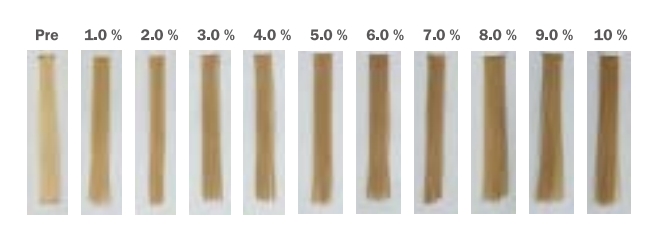
Dyeing results of hair samples dyed with shampoo samples having different concentrations of coffee grounds extract.
To investigate the ability of hair dyeing, color changes were observed based on the dyeing concentrations. Hair dyeing ability was augmented with increase in coffee grounds extract concentration across all the shampoo samples.
2) 염색기간에 따른 모발염색 효과(Day 1-Day 7)
염색기간에 따른 염색효과를 알아보기 위해 폴리페놀 성분이 함유된 커피박 추출물(CGE) 농축 농도 5%로 샴푸제형을 제조하여 7일 동안 하루에 한 번 샴푸 진행 후, L* (명도), a* (적색도), b* (황색도)값을 확인하였고 결과는 Table 5에 표기하였다. 샴푸염색 기간이 증가할수록 L*값은 점차 감소하였고, a*값은 3일까지 증가하다 감소하였 으며 b*값은 점차 증가하였다. 즉, 어두운 상태는 지속되면서 붉은 기가 높아지다 낮아지며 동시에 황색 기가 증가하여 육안으로(Figure 5) 기간이 지남에 따라 암적색으로 변화하다 갈색으로 변화되는 과정을 관찰하였다. 이는 식물성 폴리페놀의 갈변현상(Martinez & Whitaker, 1995; Nicolas et al., 1994) 즉, 식물성 폴리페놀류가 공기 중의 산소와 접촉하면서 polyphenol oxidase (폴리페놀 산화효소)에 의해 퀴논(암적색)으로 산화되고 이것이 산화, 중합, 축적되면의 갈색의 멜라닌 형성을 통해 갈변화(Chen et al., 1991; Gauillard & Richard-Forget, 1997; Kim & Uyama, 2005; Williams et al., 1986)가 되는데, 이 현상이 커피박 추출물(CGE)에 함유된 폴리페놀(Figure 2)에 의한 모발의 갈색 염색효과에 적용된 것으로 사료된다.

Colorimetric values of hair dyed with used-up coffee ground extract shampoo at different dyeing times
5. 염색모의 퇴색도(물빠짐) 측정 결과
염색모의 색상 지속력을 알아보기 위해 Figure 5에서 진행한 염색모를 선택하여 퇴색도(물빠짐)을 측정하였다. 21일차까지 측정하였고 측정결과는 Figure 6와 같다. 1일차부터 21일차까지 O.D.값 측정치 0.031-0.038로 총 측정값 범위 내에 있어 물빠짐은 없는 것으로 판단되며, 이는 시간이 지나면서 커피박 추출물(CGE)에 함유된 폴리페놀이 모발의 표피와 피질에 안정적으로 흡착된 것으로 사료된다.
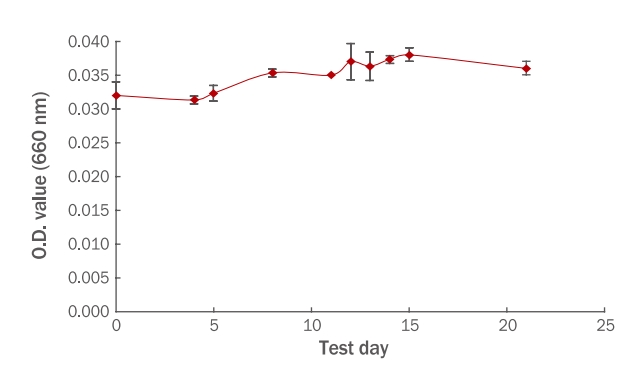
Measurement results of the fading degree for 21 days.
The optical density value was measured to examine the hair’s fading degree through bleaching. The fading degree showed no change for 21 days. Data analysis was performed using Microsoft Excel. Each value represents the mean ± standard deviation (SD) of three replicates. Error bars represent S.D., n=3.
Conclusion
본 연구는 연간 15톤으로 버려지는 커피찌꺼기의 재활용 방안으로 커피박 추출물(CGE)의 염모력을 알아보고 염모제로서의 기능이 가능한지를 살펴봄으로써 천연색소를 이용한 염모샴푸 제조에 대한 기초자료를 얻고자 하였다. 이를 위해 우선 커피박의 모발염색 가능성을 확인하기 위해 커피박 열수추출액으로 염모 하여 색변화를 관찰하였다. 커피 내 폴리페놀 성분에 의한 염모력을 확인하기 위해 커피박 추출물(CGE)의 폴리페놀 전성분 함유량을 분석하였으며 폴리페놀 성분차이에 의한 염모력 변화 또한 관찰하였다. 커피박을 추출 및 농축하여 샴푸제형으로 제조하였고, 염색성을 확인하기 위해 농도와 처리 기간을 다르게 하여 시험하였다. 커피박을 활용한 염모의 지속성 확인을 위해 염색모의 퇴색도까지 시험하였다. 모발의 염색력을 측정하기 위해 분광색차계를 사용하였고 모발의 퇴색도를 확인하기 위해 optical density (O.D. 660 nm)값을 측정하였다. 본 연구결과를 토대로 다음과 같은 결론을 얻었다.
첫째, 커피박 열수추출액을 이용한 염색에서 모발에 염착이 되어, 염모력 가능성을 입증하였다. 육안으로 사용 전과 비교시 현저한 색 변화를 확인하였고, 색차계를 통해 객관적으로 검증되었다.
둘째, 커피박 추출물 내에는 갈변현상을 유도할 수 있을 정도의 충분한 폴리페놀이 함유되었고 폴리페놀 함유량이 많을수록 염색효과가 증가하고 어두워지는 것을 알 수 있었다.
셋째, 커피박 추출물이 함유된 샴푸제형으로도 모발에 염색이 가능하며, 농도가 증가할수록 염모효과가 증가하고 L* (명도)값 또한 추출물 첨가 농도 의존적으로 낮아짐을 알 수 있었다. 샴푸제형으로 7일 동안 하루에 한 번 샴푸 진행 후 색변화를 관찰했을 때, 기간이 지남에 따라 암적색으로 변화하다 갈색으로 변화되는 과정을 확인하였다. 이는 식물성 폴리페놀의 갈변현상으로 커피박 추출물에 함유된 폴리페놀에 의한 모발의 갈색 효과에 적용된 것으로 사료된다.
넷째, 염색모의 물빠짐은 없는 것으로 판단되며, 내부 연구를 통해 커피박 추출물이 함유된 샴푸제형으로 피부 염착도 및 민감도 평가를 진행하였을 때, 물에 의해 샴푸제형이 잘 씻기며 커피박에 의한 피부 알레르기 반응도 없는 것으로 확인되었다.
이를 통해 생활폐기물로 버려지던 커피찌꺼기의 효율적인 산업적 활용방안의 대안으로 커피박을 이용한 모발 염색 활용 가능성에 대하여 실험을 통해 입증하였다. 샴푸 제형 상태에서 또한 염모력이 유지될 뿐 아니라 염착도 및 알레르기 반응도 없어 염색샴푸 개발, 더 나아가 상용화까지도 가능할 것으로 사료된다. 향후 커피박의 염모 효과를 증강시킬 수 있는 천연 매염제를 찾아 염색력 비교분석을 통해 시너지 염모효과에 대한 추가 연구를 진행하면, 모발 염색시장에 획기적인 패러다임을 제시 할 수 있을 것으로 판단된다.
Notes
Author's contribution
TYS designed all experimental investigations and wrote the manuscript. CWK, JEK and DJK assisted experimental design and collected coffee grounds extract data.
Author details
Tae-Yang Song (Laboratory Chief)/Chang Won Kim (Researcher)/Jee-Eun Ko (Researcher)/Da Jeong Kim (Researcher), Seoulin Life Science Research Institute, Seoulin Bioscience Co., Ltd, 4th floor, Building A, KOREA BIO PARK, 700, Daewangpangyo-ro, Bundang-gu, Seongnam-si, Gyeonggi-do 13488, Korea.
